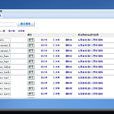版本,最新版,使用方法,創建資料庫,刪除資料庫,備份資料庫,創建新表,刪除新表,增加一個列,添加主鍵,創建索引,創建視圖,基本sql語句,高級查詢運算,使用外連線,常用語句,導表,備份,
版本
版本 | 年份 | 發布名稱 | 代號 |
4.21
(WinNT) | 1993年 | SQL Server 4.21 | - |
6.0 | 1995年 | SQL Server 6.0 | SQL95 |
6.5 | 1996年 | SQL Server 6.5 | Hydra |
7.0 | 1998年 | SQL Server 7.0 | Sphinx |
- | 1999年 | SQL Server 7.0
OLAP工具 | Plato |
8.0 | 2000年 | SQL Server 2000 | Shiloh |
8.0 | 2003年 | SQL Server 2000
64-bit 版本 | Liberty |
9.0 | 2005年 | SQL Server 2005 | Yukon |
10.0 | 2008年 | SQL Server 2008 | Katmai |
11.0 | 2010年 | SQL Server 2010 | Kilimanjaro |
12.0 | 2012年 | SQL Server 2012 | SQL2012 |
最新版
Microsoft® SQL
Server™ 是用於電子商務、業務線和數據倉庫解決方案的資料庫管理和分析系統。
SQL Server 的最新版本 2012 版新增了這樣一些特性:藉助 AlwaysOn 群集和可用性組實現的高可用性及災難恢復解決方案、使查詢速度飛速提升的 xVelocity 記憶體中存儲、藉助 Analysis Services 中的 Power View 和表格建模實現的快速數據瀏覽和可縮放業務智慧型,以及 Data Quality Services 帶來的全新數據管理能力。
使用方法
創建資料庫
CREATE DATABASE database-name
刪除資料庫
drop database dbname
備份資料庫
--- 創建 備份數據的 device
USE master
EXEC sp_addumpdevice 'disk','testBack','c:\mssql7backup\backsql.dat'
--- 開始 備份
BACKUP DATABASE pubs TO testBack
創建新表
create table tabname(col1 type1 [not null] [primary key],col2 type2 [not null],..)
根據已有的表創建新表:
create table tab_new like tab_old (使用舊錶創建新表)
create table tab_new as select col1,col2… from tab_old definition only
刪除新表
drop table tabname
增加一個列
Alter table tabname add column col type
註:列增加後將不能刪除。DB2中列加上後數據類型也不能改變,唯一能改變的是增加varchar類型的長度。
添加主鍵
Alter table tabname add primary key(col)
刪除主鍵:Alter table tabname drop primary key(col)
創建索引
create [unique] index idxname on tabname(col….)
刪除索引:drop index idxname
註:索引是不可更改的,想更改必須刪除重新建。有些語法會讓mssql失效如:select *from aa where aa like '%gg%'等,索引的合理利用將大大提高mssql對大數據量的處理效率。
創建視圖
create view viewname as select statement
刪除視圖:drop view viewname
基本sql語句
選擇:select * from table1 where 範圍
插入:insert into table1(field1,field2) values(value1,value2)
刪除:delete from table1 where 範圍
更新:update table1 set field1=value1 where 範圍
查找:select * from table1 where field1 like ’%雷鋒%’ ---like的語法很精妙,查資料!不過會讓索引失效,而select * from table1 where field1 like ’雷鋒%’ 這句的的話索引是有效的!
排序:select * from table1 order by field1,field2 [desc]
總數:select count * as totalcount from table1
求和:select sum(field1) as sumvalue from table1
平均:select avg(field1) as avgvalue from table1
最大:select max(field1) as maxvalue from table1
最小:select min(field1) as minvalue from table1
高級查詢運算
UNION 運算符通過組合其他兩個結果表(例如 TABLE1 和 TABLE2)並消去表中任何重複行而派生出一個結果表。當 ALL 隨 UNION 一起使用時(即 UNION ALL),不消除重複行。兩種情況下,
派生表的每一行不是來自 TABLE1 就是來自 TABLE2。
EXCEPT 運算符通過包括所有在 TABLE1 中但不在 TABLE2 中的行並消除所有重複行而派生出一個結果表。當 ALL 隨 EXCEPT 一起使用時 (EXCEPT ALL),不消除重複行。
INTERSECT 運算符通過只包括 TABLE1 和 TABLE2 中都有的行並消除所有重複行而派生出一個結果表。當 ALL 隨 INTERSECT 一起使用時 (INTERSECT ALL),不消除重複行。
使用外連線
SQL: select a.a,a.b,a.c,b.c,b.d,b.f froma LEFT OUT JOIN b ON a.a = b.c
右外連線(右連線):結果集既包括連線表的匹配連線行,也包括右連線表的所有行。
全
外連線:不僅包括符號
連線表的匹配行,還包括兩個連線表中的所有記錄。
常用語句
法一:select * into b from a where1<>1
法二:select top 0 * into b from a
拷貝表(拷貝數據,源表名:a 目標表名:b) (Access可用)
insert into b(a,b,c) select d,e,f from a;
跨資料庫之間表的拷貝(具體數據使用
絕對路徑) (Access可用)
insert into b(a,b,c) select d,e,f from b in ‘具體資料庫’ where 條件
例子:..from b in '"&Server.MapPath(".")&"\data.mdb" &"' where..
select a,b,c from a where a IN (select d from b) 或者: select a,b,c from a where a IN (1,2,3)
select a.title,a.username,b.adddate from table a,(select max(adddate) adddate from table where table.title=a.title) b
select a.a,a.b,a.c,b.c,b.d,b.f from a LEFT OUT JOIN b ON a.a = b.c
select * from (SELECT a,b,c FROM a) T where t.a > 1;
between的用法,between限制
查詢數據範圍時包括了邊界值,not between不包括
select * from table1 where time between time1 and time2
select a,b,c,from table1 where a not between 數值1 and 數值2
select * from table1 where a [not] in (‘值1’,’值2’,’值4’,’值6’)
delete from table1 where not exists (select * from table2 where table1.field1=table2.field1)
select * from a left inner join b on a.a=b.b right inner join c on a.a=c.c inner join d on a.a=d.d where .....
SQL: select * from
日程安排where datediff('minute',f開始時間,getdate())>5
select top 10 b.* from (select top 20 主鍵
欄位,排序欄位 from 表名 order by 排序欄位 desc) a,表名 b where b.主鍵欄位 = a.主鍵欄位 order by a.排序欄位
select top 10 * form table1 where 範圍
select a,b,c from tablename ta where a=(select max(a) from tablename tb where tb.b=ta.b)
(select a from tableA) except (select a from tableB) except (select a from tableC)
select top 10 * from tablename order by newid()
select newid()
Delete from tablename where id not in (select max(id) from tablename group by col1,col2,...)
select name from sysobjects where type='U'
select name from syscolumns where id=object_id('TableName')
列示type、vender、pcs
欄位,以type欄位排列,case可以方便地實現多重選擇,類似select 中的case。
select type,sum(case vender when 'A' then pcs else 0 end),sum(case vender when 'C' then pcs else 0 end),sum(case vender when 'B' then pcs else 0 end) FROM tablename group by type
導表
使用MySQL生成create腳本的方法。找到生成要導出的腳本,按MySQL的語法修改一下到MySQL資料庫中創建該表的列結構什麼的。
在MSSQL端使用bcp導出文本檔案:
bcp “Select * FROM dbname.dbo.tablename;” queryout tablename.txt -c -Slocalhost\db2005 -Usa
其中”"中是要導出的sql語句,-c指定使用\t進行欄位分隔,使用\n進行記錄分隔,-S指定資料庫伺服器及實例,-U指定用戶名,-P指定密碼.
在MySQL端使用mysqlimport 導入文本檔案到相應表中
mysqlimport -uroot -p databasename /home/test/tablename.txt
其中-u指定用戶名,-p指定密碼,databasename指定資料庫名稱,表名與檔案名稱相同。
備份
當我們在裝好MSsql資料庫庫後,想通過自動備份作業方式來保護好自己的資料庫時,常常遇到無法正常開啟作業。下面是使用MSSQL2005無法正常備份問題的解決方案:
DECLARE @strPath NVARCHAR(200)
set @strPath = convert(NVARCHAR(19),getdate(),120)
set @strPath = REPLACE(@strPath, ':' , '.')
set @strPath = 'E:\DATA_db\MSSQL.1\MSSQL\Backup' + @strPath + '.bak' (備份好的存入資料庫路徑【可自行更改】)
BACKUP DATABASE [MY_Data] (資料庫名,你務必與你資料庫的數據名稱一致)TO DISK = @strPath WITH NOINIT , NOUNLOAD , NOSKIP , STATS = 10, NOFORMAT

